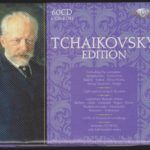Nearly every major composer has endured a watermark year in which personal crises affected the future development of his music. For Beethoven, that year was 1802, when encroaching deafness drove him to the verge of suicide. For Wagner, it was 1848 when the Dresden Revolution forced him to rethink his political convictions. For Tchaikovsky, the year of turmoil was 1877. Though his greatest masterworks still lay in the future, the composer had already proven his mettle with three symphonies, several operas, the Rococo Variations and the ballet Swan Lake. He was also benefiting from the recent acquisition of a patron, Madame Nadezhda von Meck, whose financial support had allowed him to concentrate more fully upon composition. All of those aspects were positive influences upon Tchaikovsky’s life; the crisis lay in a sudden and very ill-considered marriage. A former student of the composer’s had become deeply infatuated with him, and swore that, if he did not marry her, she would take her life. Concerned for the girl’s well-being, Tchaikovsky agreed to the marriage, even though taking a woman into his home was the last thing his own inclinations would have led him to do. They married in the summer. His nervous breakdown came in the fall, at which point his doctors recommended that he never see the young woman again. Soon, the composer and his brother Anatoly had left Russia for Switzerland in hope of finding solace for poor Peter’s battered spirit.
As so often happened, Tchaikovsky sought consolation in composition, plunging back into his sketches for the opera Eugene Onegin, and beginning the orchestration of his new symphony, the fourth of what would ultimately be six works in the genre. By late in the year, he was able to give an optimistic report to Madame von Meck, writing, ‘Never yet has any of my orchestral works cost me so much labor, but I’ve never yet felt such love for any of my things … Perhaps I’m mistaken, but it seems to me that this Symphony is better than anything I’ve done so far.’ Such enthusiasm was rather unusual for the composer, who more often expressed a loathing for his works, but here, it seems, he knew that he had exceeded even his own demanding standards. He completed the new symphony on Christmas Day, by the Russian calendar, in 1877 (January 7, 1878 by the Western calendar). The piece bore a dedication ‘to my best friend’, a reference to Madame von Meck, who agreed to accept the honor only on the grounds of anonymity.
The Fourth Symphony premiered in Moscow that same winter with the composer’s mentor Nikolay Rubinstein conducting. A few months later, a colleague of Tchaikovsky’s, the composer Sergei Taneyev, criticized the piece for being programmatic, that is, for having a plot. Tchaikovsky defended his creation, declaring, ‘I don’t see why you consider this a defect. On the contrary, I should be sorry if symphonies that mean nothing should flow from my pen, consisting solely of a progression of harmonies, rhythms and modulations … As a matter of fact, the work is patterned after Beethoven’s Fifth Symphony, not as to musical content but as to the basic idea.’ Tchaikovsky’s statement begs a question as to what this ‘basic idea’ might be. After all, the answer to that question would not only help us to interpret the Russian master’s creation; it would also shed light on what Tchaikovsky saw as the central concept of the Beethoven piece. Fortunately, Tchaikovsky provides us with an answer in a letter to Madame von Meck in which he outlined what he viewed as the program for his Fourth Symphony. According to the composer himself, the ominous opening theme for horns and bassoons represents fate hanging over one’s head like a sword. This all-consuming gloom devours the few, brief glimpses of happiness, appearing mostly in the form of waltz themes. The second movement, Tchaikovsky asserted, expresses the melancholy felt at the end of a weary day. Then, in the third movement, he imagined what he called ‘fleeting images that pass through the imagination when one has begun to drink a little wine’. The fourth movement holds Tchaikovsky’s prescription for happiness. Here’s how he described it: ‘If you cannot find reasons for happiness in yourself, look at others. Get out among the people … Oh, how gay they are! … Life is bearable after all.’ And so, to summarize Tchaikovsky’s view, this is a symphony that brings us from gloom to melancholy to slow recovery to life-affirming energy. It is a progression from darkness to light, a progression that we can sense in Tchaikovsky’s Fourth as well as in Beethoven’s Fifth.
Marche slave
The Marche slave (1876) is one of Tchaikovsky’s few musical comments on actual events. After Montenegro and Serbia declared war on Turkey because of the Turkish atrocities against Christians, a wave of religiously inspired nationalism went through Russia, Serbia’s ally. Tchaikovsky responded to this climate by writing a march which includes three Serbian folk melodies plus the national Russian anthem. The composer didn’t like the piece but didn’t say why. Maybe because he was not a fan of pomp and circumstance in bombastic form and he preferred to present existing melodies in a much more stylised form. The audience at the premiere on 17 November 1876 in Moscow had a totally different view. The piece was a tremendous success, the march had to be encored and many in the hall wept .
01. Symphony No. 4 in F minor, Op.36 – I. Andante sostenuto; moderato con anima
02. Symphony No. 4 in F minor, Op.36 – II. Andantino in modo di canzona
03. Symphony No. 4 in F minor, Op.36 – III. Scherzo. Pizzicato ostinato
04. Symphony No. 4 in F minor, Op.36 – IV. Finale. Allegro con fuoco
05. ‘Marche Slave’ for Orchestra, Op.31
London Symphony Orchestra
Gennady Rozdestvensky – Conductor
